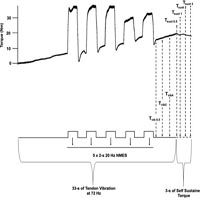 Smart Citations
Smart CitationsSee how this article has been cited at scite.ai
scite shows how a scientific paper has been cited by providing the context of the citation, a classification describing whether it supports, mentions, or contrasts the cited claim, and a label indicating in which section the citation was made.
Concurrent Achilles tendon vibration and tibial nerve stimulation to estimate persistent inward current strength in motoneurons
Vibratory (Tvib) and sustained (Tsust) torque responses to concurrent Achilles tendon vibration and neuromuscular electrical stimulation applied over the muscle belly (vib+stim) are used as indicators of motoneuron facilitation and, theoretically, persistent inward current strength. However, neuromuscular electrical stimulation (NMES) applied to the nerve trunk may potentiate motoneuronal excitability more than muscle belly NMES, yet it remains unclear whether NMES applied over the nerve evokes robust Tvib and Tsust responses when used during the vib+stim protocol. This study tested whether a nerve-targeted vib+stim protocol elicits Tvib and Tsust responses in the ankle plantar flexors with acceptable intra- and inter-session reliability. Fifteen men performed the vib+stim protocol with NMES applied over the tibial nerve three times across two sessions; twice in a single session (5-min apart) to test intrasession reliability and then again after 48 h to test intersession reliability. Intraclass correlation coefficients (ICC3,1), within-participant coefficients of variation (CV) and pairwise comparisons were used to verify relative and absolute reliability as well as systematic bias. Thirteen men presented Tvib and Tsust responses (response rate of 87%). Intrasession Tvib and Tsust ICCs were >0.73 but inter-session ICCs were <0.5. Although no systematic bias was detected (p>0.05), both intra- and inter-session CVs were large (>10%) for Tvib and Tsust. The Vib+stim protocol with NMES applied over the nerve evoked Tvib and Tsust in almost all participants, but presented a large intra- and inter-session variability. The method does not appear to be effective for assessing motoneuron facilitation in the plantar flexors.
Downloads
How to Cite
PAGEPress has chosen to apply the Creative Commons Attribution NonCommercial 4.0 International License (CC BY-NC 4.0) to all manuscripts to be published.

 https://doi.org/10.4081/ejtm.2021.10045
https://doi.org/10.4081/ejtm.2021.10045





